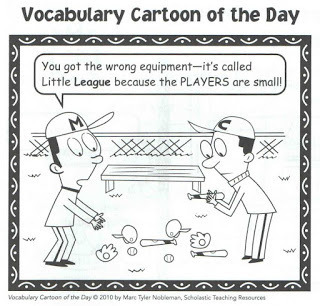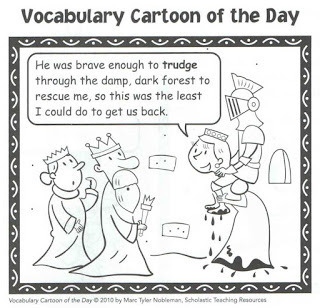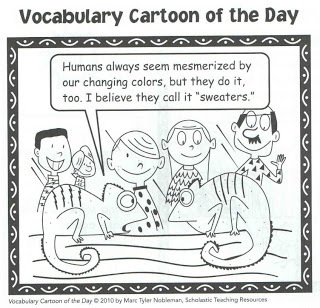Marc Tyler Nobleman's Blog, page 118
October 16, 2012
Book trailer conventions worth breaking
Are book trailers new enough that my making a single one qualifies me to dispense advice about them? Probably not, but then again, most of us sling opinions about things we’ve never done and never will do (play pro football, sing at the American Idol finals, be the leader of the free world).
And for what it’s worth, I did put in twice as much time on my trailer than I'd planned.
So…the following list of book trailer conventions worth breaking is not comprehensive, not ranked, and not likely to shatter the core of what you thought you knew, but will hopefully be helpful nonetheless:
#1 – keep it short
Generally speaking, I agree. But when someone says “It was too long,” what he probably means is “It’s not interesting enough.” Something longer and engaging is better than something short and forgettable. So rather than focusing on keeping it short, focus on keeping it watchable. (Book people tend to have longer attention spans anyway.)
#2 – show book interiors (picture books only)
If you have a clever way to do so, by all means. But if it will be just a pan-and-scan variation of the same samples that will be on Amazon, why bother? As with your book itself, take the trailer as an opportunity to give readers/viewers something they haven’t seen before…and won’t see elsewhere again. If you do include interiors, I encourage you to include something else as well.
#3 – explain the premise in detail
Surely your book is resplendent, but sell it with a tease, not a torrent. Think back cover, not inside front flap.
#4 – (related) use intertitles plentifully
Yes, books are read—but book trailers don’t have to be. Every project should take ample advantage of its medium. Therefore, in making a trailer, pay attention to words, yes, but also to sound, pacing, composition, and other aspects of filmmaking. In fact, a good challenge: use as few intertitles as you can.
#5 – avoid material that is not in the book
What for? You’re not studying for a test! Actually, an interesting tidbit that for whatever reason did not make it into your book could be the hinge of a good trailer! In ‘80s TV parlance, such a tidbit was often called a “blooper.” On DVDs and downloads, it is called a “deleted scene.” And in this case “deleted” is a positive; “deleted” = “I want.”
#6 – do not have Batman in your trailer
No, do. If your book allows for it, and you stick to fair use, and you can bribe someone to don the costume, you will confirm what Gotham City has known for 70+ years: it’s nice to have the Dark Knight on your side.
If you want to see examples of each of the above in action, here is my trailer.
You want your book to stand out so be sure your book trailer does, too. Good luck, multi-hyphenates!

And for what it’s worth, I did put in twice as much time on my trailer than I'd planned.
So…the following list of book trailer conventions worth breaking is not comprehensive, not ranked, and not likely to shatter the core of what you thought you knew, but will hopefully be helpful nonetheless:
#1 – keep it short
Generally speaking, I agree. But when someone says “It was too long,” what he probably means is “It’s not interesting enough.” Something longer and engaging is better than something short and forgettable. So rather than focusing on keeping it short, focus on keeping it watchable. (Book people tend to have longer attention spans anyway.)
#2 – show book interiors (picture books only)
If you have a clever way to do so, by all means. But if it will be just a pan-and-scan variation of the same samples that will be on Amazon, why bother? As with your book itself, take the trailer as an opportunity to give readers/viewers something they haven’t seen before…and won’t see elsewhere again. If you do include interiors, I encourage you to include something else as well.
#3 – explain the premise in detail
Surely your book is resplendent, but sell it with a tease, not a torrent. Think back cover, not inside front flap.
#4 – (related) use intertitles plentifully
Yes, books are read—but book trailers don’t have to be. Every project should take ample advantage of its medium. Therefore, in making a trailer, pay attention to words, yes, but also to sound, pacing, composition, and other aspects of filmmaking. In fact, a good challenge: use as few intertitles as you can.
#5 – avoid material that is not in the book
What for? You’re not studying for a test! Actually, an interesting tidbit that for whatever reason did not make it into your book could be the hinge of a good trailer! In ‘80s TV parlance, such a tidbit was often called a “blooper.” On DVDs and downloads, it is called a “deleted scene.” And in this case “deleted” is a positive; “deleted” = “I want.”
#6 – do not have Batman in your trailer
No, do. If your book allows for it, and you stick to fair use, and you can bribe someone to don the costume, you will confirm what Gotham City has known for 70+ years: it’s nice to have the Dark Knight on your side.
If you want to see examples of each of the above in action, here is my trailer.
You want your book to stand out so be sure your book trailer does, too. Good luck, multi-hyphenates!
Published on October 16, 2012 04:00
October 12, 2012
Calling all gays and lesbians of 1980s New York
While researching Bill the Boy Wonder: The Secret Co-Creator of Batman, I went to nutty lengths to find people who knew Bill Finger or his family. Given that Bill had died in 1974 and left less trace than you would believe, I had little choice.
His first wife Portia died in 1990, so I felt I had a shot of finding friends of hers, many of whom were gay. There is a gay and lesbian center near where she was living when she died, so I made this flyer and posted it there:
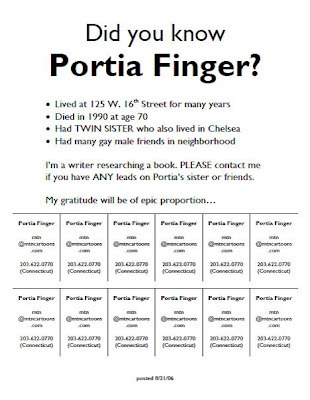 Since that didn’t work, I’m posting it here.
Since that didn’t work, I’m posting it here.
(By the way, the phone number is old and inactive.)

His first wife Portia died in 1990, so I felt I had a shot of finding friends of hers, many of whom were gay. There is a gay and lesbian center near where she was living when she died, so I made this flyer and posted it there:
 Since that didn’t work, I’m posting it here.
Since that didn’t work, I’m posting it here.(By the way, the phone number is old and inactive.)
Published on October 12, 2012 04:16
October 11, 2012
Favorites from "Vocabulary Cartoon of the Day" (grades 2-3), round 3
Published on October 11, 2012 04:00
October 9, 2012
Favorites from "Vocabulary Cartoon of the Day" (grades 2-3), round 2
Published on October 09, 2012 04:00
October 8, 2012
Bill Finger mystery quotations: SOLVED
In June 2008, I posted a cry for help.
I asked if anyone could source eight unattributed Bill Finger quotations in Batman: The Complete History by the late Les Daniels.
Les couldn’t.
And no one else responded, either.
Meanwhile, a never-published interview with Bill was allegedly lost among the immense comics-related clutter of the Vermont house of longtime Batman fan Tom Fagan. At the time, I was already on the hunt for it. In fact I’d mentioned it here in March 2008.
A confidante of Tom’s told me that a team of five people searching Tom’s house eight hours a day for a month would put barely a dent in his “archives.”
(You may see where I’m going with all this.)
In December 2006, the first and only time I spoke on the phone with Tom, he’d kindly given me clearance to come up and search whenever I wanted; I could even crash on his couch (presuming it wasn’t buried in boxes and papers like much of the rest of the house). But on 10/21/08, before I had acted on this offer, Tom died.
(Yes, almost two years had elapsed since Tom invited me. I hadn’t been able to get to Vermont due to family and work, and I was not pushing myself to find a way because, given the mass of material there, it seemed unlikely that I would find what I was looking for. I’m an optimist but also a pragmatist.)
Tom’s death ended up saving me a lot of time. I was in contact with Tom’s close friend, and he was a good soul. In cleaning out Tom’s house, the Bill interview was uncovered, except it wasn’t exactly an interview; it was an article Tom wrote in 1965 and did not publish anywhere. Amid the grief and chaos that follows the death of a loved one, Tom’s friend took the time to send me a copy of it, making him my friend now, too.
I received the typed, eight-page article on 2/8/09, which just so happened to be Bill’s 95th birthday. Weirdly, on page 3, the article mentions Bill’s birthday.
Also weirdly: though I read and took notes from Tom’s article immediately, it wasn’t until March 2010—yes, more than a year later—when my June 2008 post popped back into my head. (I combine all research notes for any given project into one Word document so I can easily search a single time when looking for information. For Bill the Boy Wonder, that document is currently 712 pages—and still growing even though the book is out.)
Thinking I’d pasted the June 2008 blog post in that research document, I searched it for one of the unsourced quotations. I got a hit—not because I’d pasted the blog post there but rather because I’d pasted the notes I took from Tom’s piece there! So I checked the other unsourced Bill quotations from Daniels’s book.
Every one of them had come from Tom’s “lost” article. Apparently it was not as lost as I was led to believe.
This discovery implied that DC, which authorized Daniels’s book, had a copy of Fagan’s piece; given the fact that Daniels had not saved his notes, he didn’t strike me as the kind of researcher who would have dug this up on his own.
Once it came into focus that Tom’s piece didn’t reveal much new that suited my needs (most of the best bits were in Daniels’s book), it made me reassess what its value was. Just the fact that it was a document on Bill written by someone who knew him personally made it worthwhile to me.
So at long last, below is “Bill Finger—The Man Behind the Legend,” the fabled “lost” article by Tom Fagan, written in 1965 when Bill was 51 years old. The most important word in it is “the”—the “the” in the last line.
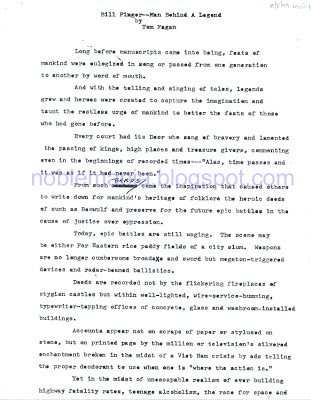
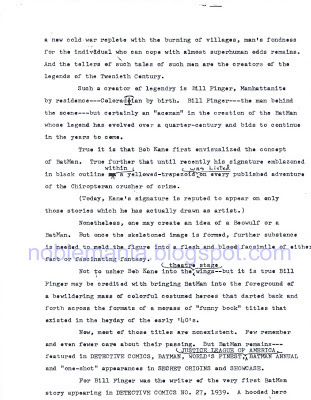
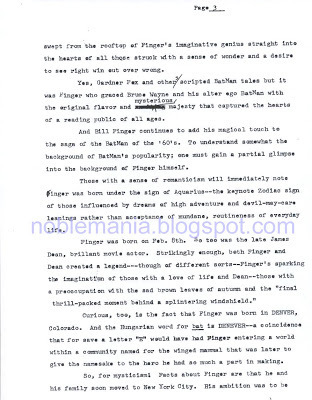
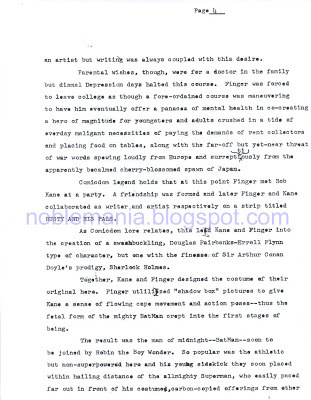
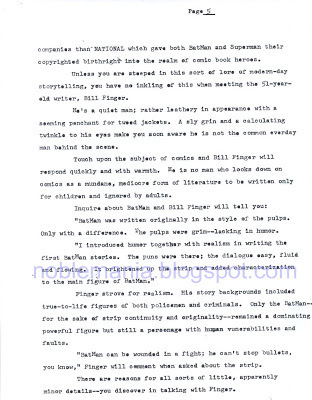
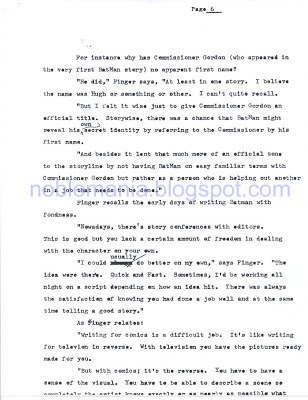
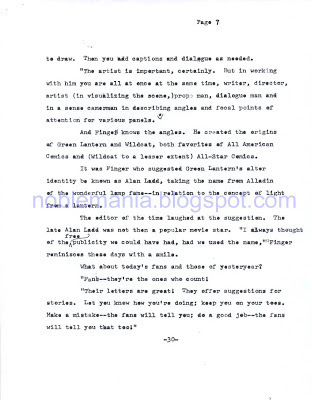
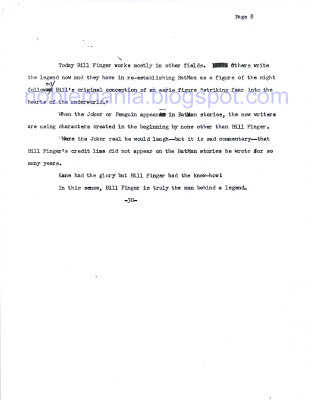

I asked if anyone could source eight unattributed Bill Finger quotations in Batman: The Complete History by the late Les Daniels.
Les couldn’t.
And no one else responded, either.
Meanwhile, a never-published interview with Bill was allegedly lost among the immense comics-related clutter of the Vermont house of longtime Batman fan Tom Fagan. At the time, I was already on the hunt for it. In fact I’d mentioned it here in March 2008.
A confidante of Tom’s told me that a team of five people searching Tom’s house eight hours a day for a month would put barely a dent in his “archives.”
(You may see where I’m going with all this.)
In December 2006, the first and only time I spoke on the phone with Tom, he’d kindly given me clearance to come up and search whenever I wanted; I could even crash on his couch (presuming it wasn’t buried in boxes and papers like much of the rest of the house). But on 10/21/08, before I had acted on this offer, Tom died.
(Yes, almost two years had elapsed since Tom invited me. I hadn’t been able to get to Vermont due to family and work, and I was not pushing myself to find a way because, given the mass of material there, it seemed unlikely that I would find what I was looking for. I’m an optimist but also a pragmatist.)
Tom’s death ended up saving me a lot of time. I was in contact with Tom’s close friend, and he was a good soul. In cleaning out Tom’s house, the Bill interview was uncovered, except it wasn’t exactly an interview; it was an article Tom wrote in 1965 and did not publish anywhere. Amid the grief and chaos that follows the death of a loved one, Tom’s friend took the time to send me a copy of it, making him my friend now, too.
I received the typed, eight-page article on 2/8/09, which just so happened to be Bill’s 95th birthday. Weirdly, on page 3, the article mentions Bill’s birthday.
Also weirdly: though I read and took notes from Tom’s article immediately, it wasn’t until March 2010—yes, more than a year later—when my June 2008 post popped back into my head. (I combine all research notes for any given project into one Word document so I can easily search a single time when looking for information. For Bill the Boy Wonder, that document is currently 712 pages—and still growing even though the book is out.)
Thinking I’d pasted the June 2008 blog post in that research document, I searched it for one of the unsourced quotations. I got a hit—not because I’d pasted the blog post there but rather because I’d pasted the notes I took from Tom’s piece there! So I checked the other unsourced Bill quotations from Daniels’s book.
Every one of them had come from Tom’s “lost” article. Apparently it was not as lost as I was led to believe.
This discovery implied that DC, which authorized Daniels’s book, had a copy of Fagan’s piece; given the fact that Daniels had not saved his notes, he didn’t strike me as the kind of researcher who would have dug this up on his own.
Once it came into focus that Tom’s piece didn’t reveal much new that suited my needs (most of the best bits were in Daniels’s book), it made me reassess what its value was. Just the fact that it was a document on Bill written by someone who knew him personally made it worthwhile to me.
So at long last, below is “Bill Finger—The Man Behind the Legend,” the fabled “lost” article by Tom Fagan, written in 1965 when Bill was 51 years old. The most important word in it is “the”—the “the” in the last line.








Published on October 08, 2012 04:45
October 5, 2012
Bat-Man vs. Bird-Man
In the 2008 book The DC Vault, a curious story is recounted. In 1973, Bill Finger said the character Bob Kane showed him on that fateful day in early 1939 was named not “Bat-Man” but rather “Bird-Man.” That had been reported before, notably in Gerard Jones’s Men of Tomorrow.
However, it is what The DC Vault said next that gets the vote for “Most Startling”: the book states that it was Bill who then suggested the bat motif, and, by implication/extension, the name “Bat-Man.”
This is significant because The DC Vault was sanctioned by DC Comics. In other words, DC is crediting Bill, not Bob, with a key component of a character for which only Bob is officially credited. I love this, and it’s risky for DC, even if it’s true.
That said, in Bill the Boy Wonder: The Secret Co-Creator of Batman, the name “Bat-Man” is the only creative element for which I give Bob credit. I did that because Bill himself did (in The Steranko History of Comics, Volume 1). As I’ve written multiple times on this blog, memory is unreliable, but sometimes it’s all we’ve got, and even when it pains me (as in a case like this), I will go with the primary subject’s take over anyone else’s.
But there are other possibilities: Bill’s decades of credit suppression might have led to simple surrender—or brainwashing. Perhaps Bill did suggest “Bat-Man” but later felt he had to go along with Bob’s claim to it since it would be his word against Bob’s. Or perhaps in a complete collapse of self-esteem, Bill actually came to believe the name was Bob’s idea.
It is widely agreed upon that the character Bob initially sketched was indeed named Bird-Man; yet lacking firm evidence in Bill’s favor, I stand by the belief that it was Bob who changed the name to Bat-Man. But did he do so before he showed Bill? I don’t—and we may never—know.
Either way, I’m comforted by two larger points:
A bat-themed character was hardly unique in those days (which only lends more weight to Bob—hardly an innovator—choosing the name). Other varieties of Batmen had graced pulps and films before 1939.
Even if Bill was right and the name did come from Bob, most everything else—including the aspects of Batman that made him an enduring icon—came from Bill.
However, it is what The DC Vault said next that gets the vote for “Most Startling”: the book states that it was Bill who then suggested the bat motif, and, by implication/extension, the name “Bat-Man.”
This is significant because The DC Vault was sanctioned by DC Comics. In other words, DC is crediting Bill, not Bob, with a key component of a character for which only Bob is officially credited. I love this, and it’s risky for DC, even if it’s true.
That said, in Bill the Boy Wonder: The Secret Co-Creator of Batman, the name “Bat-Man” is the only creative element for which I give Bob credit. I did that because Bill himself did (in The Steranko History of Comics, Volume 1). As I’ve written multiple times on this blog, memory is unreliable, but sometimes it’s all we’ve got, and even when it pains me (as in a case like this), I will go with the primary subject’s take over anyone else’s.
But there are other possibilities: Bill’s decades of credit suppression might have led to simple surrender—or brainwashing. Perhaps Bill did suggest “Bat-Man” but later felt he had to go along with Bob’s claim to it since it would be his word against Bob’s. Or perhaps in a complete collapse of self-esteem, Bill actually came to believe the name was Bob’s idea.
It is widely agreed upon that the character Bob initially sketched was indeed named Bird-Man; yet lacking firm evidence in Bill’s favor, I stand by the belief that it was Bob who changed the name to Bat-Man. But did he do so before he showed Bill? I don’t—and we may never—know.
Either way, I’m comforted by two larger points:
A bat-themed character was hardly unique in those days (which only lends more weight to Bob—hardly an innovator—choosing the name). Other varieties of Batmen had graced pulps and films before 1939.
Even if Bill was right and the name did come from Bob, most everything else—including the aspects of Batman that made him an enduring icon—came from Bill.
Published on October 05, 2012 04:22
October 4, 2012
Favorites from "Vocabulary Cartoon of the Day" (grades 2-3), round 1
Published on October 04, 2012 04:00
October 3, 2012
"Lousy Reputation" by We Are Scientists
The trailer for Bill the Boy Wonder: The Secret Co-Creator of Batman features one of my favorite songs, "Try," by the (now-defunct) folk rock duo Billy Pilgrim. (These days, one is a wonderful solo singer-songwriter and the other is part of another talented band, Sugarland.)
Another top choice for the trailer was "Lousy Reputation" by We Are Scientists, one of whom I've had the pleasure of meeting at the Union League Club Book Fair.
It's a propulsive song and the lyrics sound as though they could have been written by Bill Finger about Bob Kane...or possibly the other way around.

Another top choice for the trailer was "Lousy Reputation" by We Are Scientists, one of whom I've had the pleasure of meeting at the Union League Club Book Fair.
It's a propulsive song and the lyrics sound as though they could have been written by Bill Finger about Bob Kane...or possibly the other way around.
Published on October 03, 2012 04:52
September 30, 2012
Contacting the people in the building where Batman began
In 2011, I made pilgrimage to the Bronx apartment building in which Bill Finger lived in 1939—in other words, the building in which Batman was likely created. Surprise—the owners did not know the Batman connection. But that made the experience more fun for me.
I had not wanted to show up unannounced, but I didn’t know who was living there. So I had to resort to a tactic I’d used when trying to get inside the house in which Jerry Siegel lived when he dreamed up Superman: sending a letter not addressed to anyone by name.
Here’s the Finger letter:
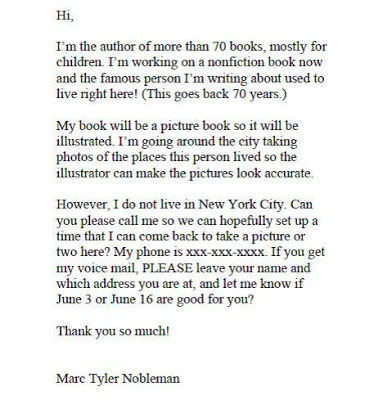 Guess why I did not specify the "famous person"?
Guess why I did not specify the "famous person"?
I hoped the tease would increase my chances of a response, if for no other reason than to satisfy curiosity.
But with Finger as with Siegel, I did not hear back from anyone. They left me no choice but to show up unannounced.

I had not wanted to show up unannounced, but I didn’t know who was living there. So I had to resort to a tactic I’d used when trying to get inside the house in which Jerry Siegel lived when he dreamed up Superman: sending a letter not addressed to anyone by name.
Here’s the Finger letter:
 Guess why I did not specify the "famous person"?
Guess why I did not specify the "famous person"?I hoped the tease would increase my chances of a response, if for no other reason than to satisfy curiosity.
But with Finger as with Siegel, I did not hear back from anyone. They left me no choice but to show up unannounced.
Published on September 30, 2012 04:46
September 27, 2012
Where my cartoons appeared
From 1998 to 2002, I regularly submitted single-panel (gag) cartoons to dozens of magazines and other publications in the United States, the United Kingdom, and occasionally elsewhere; since 2002, I submit more sporadically, and also take on various cartooning projects that come to me.
Here are the logos of most of the magazines to which I licensed cartoons around the turn of the century (many of which no longer exist):




Here are the logos of most of the magazines to which I licensed cartoons around the turn of the century (many of which no longer exist):



Published on September 27, 2012 04:00





